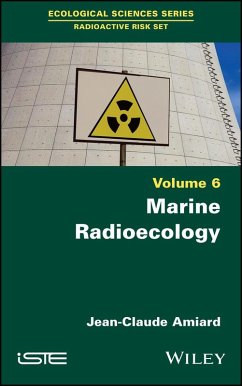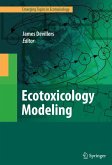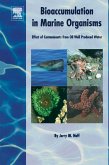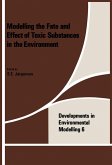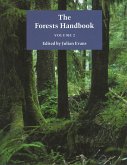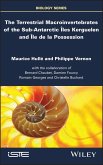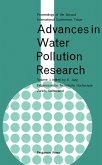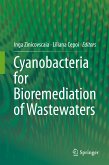Jean-Claude Amiard
Marine Radioecology, Volume 6 (eBook, PDF)
126,99 €
126,99 €
inkl. MwSt.
Sofort per Download lieferbar

0 °P sammeln
126,99 €
Als Download kaufen

126,99 €
inkl. MwSt.
Sofort per Download lieferbar

0 °P sammeln
Jetzt verschenken
Alle Infos zum eBook verschenken
126,99 €
inkl. MwSt.
Sofort per Download lieferbar
Alle Infos zum eBook verschenken

0 °P sammeln
Jean-Claude Amiard
Marine Radioecology, Volume 6 (eBook, PDF)
- Format: PDF
- Merkliste
- Auf die Merkliste
- Bewerten Bewerten
- Teilen
- Produkt teilen
- Produkterinnerung
- Produkterinnerung

Bitte loggen Sie sich zunächst in Ihr Kundenkonto ein oder registrieren Sie sich bei
bücher.de, um das eBook-Abo tolino select nutzen zu können.
Hier können Sie sich einloggen
Hier können Sie sich einloggen
Sie sind bereits eingeloggt. Klicken Sie auf 2. tolino select Abo, um fortzufahren.

Bitte loggen Sie sich zunächst in Ihr Kundenkonto ein oder registrieren Sie sich bei bücher.de, um das eBook-Abo tolino select nutzen zu können.
The marine environment, in addition to a not insignificant background of "natural" radioactivity, has continued to receive inputs of radionuclides directly or indirectly through atomic fallout, discharges from the nuclear industry or from nuclear accidents. After their introduction, the fate of these radionuclides is complex with modifications of physicochemical forms, dispersion in marine water masses and adsorption onto sedimentary particles. Marine organisms then bioaccumulate these radionuclides to a greater or lesser extent, dispersing them via their burrowing activities, horizontal and…mehr
- Geräte: PC
- ohne Kopierschutz
- eBook Hilfe
Andere Kunden interessierten sich auch für
![Ecotoxicology Modeling (eBook, PDF) Ecotoxicology Modeling (eBook, PDF)]() Ecotoxicology Modeling (eBook, PDF)113,95 €
Ecotoxicology Modeling (eBook, PDF)113,95 €![Bioaccumulation in Marine Organisms (eBook, PDF) Bioaccumulation in Marine Organisms (eBook, PDF)]() J. M. NeffBioaccumulation in Marine Organisms (eBook, PDF)121,95 €
J. M. NeffBioaccumulation in Marine Organisms (eBook, PDF)121,95 €![Modeling the Fate and Effect of the Toxic Substances in the Environment (eBook, PDF) Modeling the Fate and Effect of the Toxic Substances in the Environment (eBook, PDF)]() Modeling the Fate and Effect of the Toxic Substances in the Environment (eBook, PDF)40,95 €
Modeling the Fate and Effect of the Toxic Substances in the Environment (eBook, PDF)40,95 €![The Forests Handbook, Volume 2 (eBook, PDF) The Forests Handbook, Volume 2 (eBook, PDF)]() The Forests Handbook, Volume 2 (eBook, PDF)223,99 €
The Forests Handbook, Volume 2 (eBook, PDF)223,99 €![The Terrestrial Macroinvertebrates of the Sub-Antarctic Iles Kerguelen and Ile de la Possession (eBook, PDF) The Terrestrial Macroinvertebrates of the Sub-Antarctic Iles Kerguelen and Ile de la Possession (eBook, PDF)]() Maurice HulleThe Terrestrial Macroinvertebrates of the Sub-Antarctic Iles Kerguelen and Ile de la Possession (eBook, PDF)139,99 €
Maurice HulleThe Terrestrial Macroinvertebrates of the Sub-Antarctic Iles Kerguelen and Ile de la Possession (eBook, PDF)139,99 €![Advances in Water Pollution Research (eBook, PDF) Advances in Water Pollution Research (eBook, PDF)]() Advances in Water Pollution Research (eBook, PDF)40,95 €
Advances in Water Pollution Research (eBook, PDF)40,95 €![Cyanobacteria for Bioremediation of Wastewaters (eBook, PDF) Cyanobacteria for Bioremediation of Wastewaters (eBook, PDF)]() Cyanobacteria for Bioremediation of Wastewaters (eBook, PDF)73,95 €
Cyanobacteria for Bioremediation of Wastewaters (eBook, PDF)73,95 €-
-
-
The marine environment, in addition to a not insignificant background of "natural" radioactivity, has continued to receive inputs of radionuclides directly or indirectly through atomic fallout, discharges from the nuclear industry or from nuclear accidents. After their introduction, the fate of these radionuclides is complex with modifications of physicochemical forms, dispersion in marine water masses and adsorption onto sedimentary particles. Marine organisms then bioaccumulate these radionuclides to a greater or lesser extent, dispersing them via their burrowing activities, horizontal and vertical migrations or through food webs.
All of these phenomena lead to very variable radioactive contamination, depending on location and the nature of the marine environments concerned, and consequently, to very different doses of irradiation to marine organisms. The harmful effects of ionizing radiation on living marine organisms are felt at varying levels of biological organization from the molecule to the ecosystem, passing through the cell, the organ, the individual and the population. In the end, the radioactive risk for marine organisms can decline according to several situations, which can be normal, programmed or accidental.
All of these phenomena lead to very variable radioactive contamination, depending on location and the nature of the marine environments concerned, and consequently, to very different doses of irradiation to marine organisms. The harmful effects of ionizing radiation on living marine organisms are felt at varying levels of biological organization from the molecule to the ecosystem, passing through the cell, the organ, the individual and the population. In the end, the radioactive risk for marine organisms can decline according to several situations, which can be normal, programmed or accidental.
Dieser Download kann aus rechtlichen Gründen nur mit Rechnungsadresse in D ausgeliefert werden.
Produktdetails
- Produktdetails
- Verlag: John Wiley & Sons
- Erscheinungstermin: 29. November 2022
- Englisch
- ISBN-13: 9781394186075
- Artikelnr.: 66898993
- Verlag: John Wiley & Sons
- Erscheinungstermin: 29. November 2022
- Englisch
- ISBN-13: 9781394186075
- Artikelnr.: 66898993
- Herstellerkennzeichnung Die Herstellerinformationen sind derzeit nicht verfügbar.
Jean-Claude Amiard is a Doctor of Science (State) in radioecology, Director of Research Emeritus at the CNRS (University of Nantes, France) and former Associate Professor in Quebec and China. He is the author of more than 250 publications, 80 books/chapters and 150 communications at international conferences.
Preface xi
Acknowledgments xv
Chapter 1 General Information on Marine Radioecology and on Risk Assessment
1
1.1 General information on radioecology 1
1.1.1 History of radioecology 2
1.1.2 The main marine radioecology laboratories 3
1.1.3. The triad of radioecology: exposure, bioaccumulation and adverse
effect 4
1.2 The principle of risk assessment 7
1.3 The particular case of the risk linked to ionizing radiation 11
Chapter 2 The Origins of Radionuclides in Marine Environments 13
2.1. Natural or anthropogenic origins of radionuclides in the marine
environment 13
2.2 The natural origins of radionuclides 15
2.3 The military origins of anthropogenic radionuclides 17
2.3.1. Radionuclides due to atmospheric fallout from atomic device
explosions 18
2.3.2 Direct releases of radionuclides from nuclear deterrence activities
25
2.3.3 Indirect releases of radionuclides due to nuclear deterrence
activities 26
2.4. Civilian origins of anthropogenic radionuclides related to the nuclear
fuel cycle 27
2.4.1 Uranium mines and nuclear fuel fabrication plants 28
2.4.2 The use of nuclear fuel 29
2.4.3 Spent fuel reprocessing plants 32
2.5 The origins of anthropogenic radionuclides linked to accidents 35
2.5.1 The Thule accident 37
2.5.2 Releases due to submarine accidents 37
2.5.3 The Chernobyl accident 37
2.5.4 The Fukushima accident 38
2.6 Indirect anthropogenic origins due to rivers and groundwater 40
2.7 Anthropogenic origins of radioactive waste 41
2.8 Conclusion 43
Chapter 3 The Fate of Radionuclides in the Marine Environment 47
3.1 The introduction of radionuclides into the marine environment 47
3.1.1 Diffuse or limited, chronic or intermittent introduction of
radionuclides into the marine environment 47
3.1.2 Chemical speciation of radionuclides during their introduction into
the environment 47
3.2 The behavior of radionuclides in the marine environment 48
3.2.1 Conservative and non-conservative radionuclides 48
3.2.2 The distribution coefficient Kd 49
3.2.3 Factors influencing Kd 51
3.2.4 Chemical speciation of radionuclides 61
3.2.5 The physico-chemical behavior of radionuclides in marine waters 63
3.3 Dispersion of radionuclides in marine waters 67
3.3.1 The passage of radionuclides through estuaries 67
3.3.2 Dispersion in marine waters 71
3.4 Dispersion of radionuclides with marine sedimentary particles 80
3.5 Conclusion 81
Chapter 4 The Fate of Radionuclides in the Marine Biosphere 83
4.1 Introduction 83
4.2 Penetration pathways of radionuclides in living organisms 84
4.2.1 Exposure pathways of flora and fauna 84
4.2.2 Transmembrane passages 84
4.2.3 Body distribution 86
4.3 Radionuclide bioaccumulation mechanisms 86
4.3.1 Accumulation mechanisms in plants 87
4.3.2 Accumulation mechanisms in animals 89
4.4 Influence of ecological factors on radioactive contamination 93
4.4.1 Influence of abiotic factors on radioactive contamination of aquatic
organisms 94
4.4.2 Biological factors in the contamination of organisms 99
4.4.3 Influence of living organisms on the cycle of radionuclides in the
aquatic environment 101
4.5 The organotropism of radionuclides 106
4.6 The mechanisms for the chemical detoxification of radionuclides 108
4.6.1 Chemical detoxification in animals: biomineralization and induction
of metallothionein 108
4.6.2 Storage forms and chemical speciation of radionuclides in organisms
109
4.6.3 Influence of chemical speciation in the biota on trophic transfers
110
4.7 Disposal of radionuclides 111
4.8 Quantification of radionuclide transfers to organisms 114
4.8.1 The various methodologies for estimating radionuclide transfers 115
4.8.2. Transfer of radionuclides from water to organisms or
bioconcentration 116
4.8.3 Transfer of radionuclides from sediment to benthic organisms 120
4.8.4 Trophic transfers of radionuclides 121
4.9 Conclusion 130
Chapter 5 Radioactive Contamination of the Marine Environment and
Monitoring Programs 135
5.1 Introduction 135
5.2 Radioactive contamination of marine environments 136
5.2.1 Radioactive contamination by natural radionuclides 136
5.2.2 The current state of radioactive contamination of the marine
environment 140
5.2.3 The marine sites of atmospheric atomic tests 142
5.2.4 Sites affected by atmospheric deposition 150
5.2.5 Sites contaminated by spent fuel reprocessing plants 154
5.2.6 Sites affected by nuclear accidents 159
5.2.7 Sites affected by submerged radioactive waste 163
5.2.8 Sites with little impact from radioactive pollution 164
5.3 Environmental radiological monitoring networks 165
5.3.1 General information 165
5.3.2 Environmental monitoring using bioaccumulators 167
5.4 International and regional marine environmental monitoring networks 170
5.4.1 The work of the IAEA in the field of the marine environment 170
5.4.2 OSPAR radiological monitoring 170
5.4.3 The northern sea networks 172
5.5 Radiological monitoring in France 173
5.5.1 Principles of control 174
5.5.2 The IRSN monitoring network 175
5.5.3 RNM (Réseau national de mesures de la radioactivité de
l'environnement) 176
5.6 Conclusion 177
Chapter 6 Radiation Doses Received by Marine Organisms 179
6.1 Introduction 179
6.2 Methodologies for estimating the dose given to marine organisms 179
6.2.1 The units of radiation doses 181
6.2.2 The difficulties of estimating the radiation dose 182
6.3 Examples of natural radiation doses to marine organisms 182
6.3.1 Pelagic marine organisms 184
6.3.2 Benthic marine organisms 185
6.3.3 Deep-sea marine organisms and hydrothermal sources 185
6.4 Examples of anthropogenic radiation doses to organisms 186
6.4.1 Irradiation doses resulting from the testing of atomic bombs 186
6.4.2 Radiation doses resulting from nuclear accidents 187
6.4.3 Irradiation dose from spent fuel reprocessing plants 190
6.4.4 Radiation dose from oil and gas operations 191
6.4.5 Irradiation dose due to experimental contamination 192
6.5 The ICRP approach 193
6.5.1 Reference organisms (RAP, Reference Animal or Plant) 193
6.5.2 Limitations of the methodology 194
6.5.3 Towards essential improvements 195
6.6 Systematic underestimation of the dose received by organisms 197
6.7 Conclusion 198
Chapter 7 Effects of Irradiation on Marine Organisms 199
7.1 General information on the effects of irradiation 199
7.1.1 Modes of action of ionizing radiation 199
7.1.2 Deterministic and stochastic effects 200
7.2 Effects of ionizing radiation at the molecular level 201
7.2.1 Effects on DNA 201
7.2.2 Induction of cytogenetic and genetic effects 204
7.2.3 Effects on other biomolecules 205
7.3 Effects of irradiation at the subcellular and cellular levels 206
7.3.1 Physical alterations of chromosome structure 206
7.3.2 Histopathological changes 207
7.3.3 Induction of defense and damage biomarkers 208
7.4 Effects of irradiation on individuals 208
7.4.1 Mortality 210
7.4.2 Alteration of reproduction 212
7.4.3 Influence of the vital stage 219
7.4.4 Radiosensitivity and radioresistance of organisms 221
7.4.5 Conclusions on the effects of irradiation at the individual level 223
7.5 Ecological community effects of irradiation 223
7.5.1 Monitoring of highly contaminated areas 224
7.5.2 Partial conclusions 225
7.6 Confounding factors on the effects of irradiation 225
7.7. Systematic under-evaluation of the biological effects of ionizing
radiation 228
7.7.1 Harmfulness according to life stage 228
7.7.2 Harmfulness by tissue or organ 228
7.7.3 Harmfulness according to emitters 228
7.7.4 Not taking into account the bystander effect 228
7.7.5 Failure to take into account the interactions between the effects of
radionuclides 229
7.7.6 Failure to take into account biodiversity in the marine environment
229
7.8 Conclusion 229
Chapter 8. Characterization of Radioactive Risk in Marine Organisms 233
8.1 The principle of radioactive risk characterization 233
8.1.1 International organizations involved in radioactive risk assessment
234
8.1.2 European research 235
8.2 Methods for selecting reference values 236
8.2.1 The ICRP approach 236
8.2.2 The ERICA approach 236
8.3 Tools for assessing radioactive risk to non-human organisms 237
8.3.1 The ERICA tool 237
8.3.2 The FASSET database 238
8.4 Recommendations of radiation doses for marine organisms 239
8.5 Applications and feedback 241
8.6 Gaps in the characterization of radioactive risk 243
8.6.1. Position of international organizations with respect to the ICRP
approach 243
8.6.2 Transgenerational effects 243
8.6.3 Ignorance of biodiversity 244
8.6.4 The choice of the threshold adverse effect 244
8.7 Conclusion 245
Conclusion 247
List of Acronyms 257
References 261
Index 311
Acknowledgments xv
Chapter 1 General Information on Marine Radioecology and on Risk Assessment
1
1.1 General information on radioecology 1
1.1.1 History of radioecology 2
1.1.2 The main marine radioecology laboratories 3
1.1.3. The triad of radioecology: exposure, bioaccumulation and adverse
effect 4
1.2 The principle of risk assessment 7
1.3 The particular case of the risk linked to ionizing radiation 11
Chapter 2 The Origins of Radionuclides in Marine Environments 13
2.1. Natural or anthropogenic origins of radionuclides in the marine
environment 13
2.2 The natural origins of radionuclides 15
2.3 The military origins of anthropogenic radionuclides 17
2.3.1. Radionuclides due to atmospheric fallout from atomic device
explosions 18
2.3.2 Direct releases of radionuclides from nuclear deterrence activities
25
2.3.3 Indirect releases of radionuclides due to nuclear deterrence
activities 26
2.4. Civilian origins of anthropogenic radionuclides related to the nuclear
fuel cycle 27
2.4.1 Uranium mines and nuclear fuel fabrication plants 28
2.4.2 The use of nuclear fuel 29
2.4.3 Spent fuel reprocessing plants 32
2.5 The origins of anthropogenic radionuclides linked to accidents 35
2.5.1 The Thule accident 37
2.5.2 Releases due to submarine accidents 37
2.5.3 The Chernobyl accident 37
2.5.4 The Fukushima accident 38
2.6 Indirect anthropogenic origins due to rivers and groundwater 40
2.7 Anthropogenic origins of radioactive waste 41
2.8 Conclusion 43
Chapter 3 The Fate of Radionuclides in the Marine Environment 47
3.1 The introduction of radionuclides into the marine environment 47
3.1.1 Diffuse or limited, chronic or intermittent introduction of
radionuclides into the marine environment 47
3.1.2 Chemical speciation of radionuclides during their introduction into
the environment 47
3.2 The behavior of radionuclides in the marine environment 48
3.2.1 Conservative and non-conservative radionuclides 48
3.2.2 The distribution coefficient Kd 49
3.2.3 Factors influencing Kd 51
3.2.4 Chemical speciation of radionuclides 61
3.2.5 The physico-chemical behavior of radionuclides in marine waters 63
3.3 Dispersion of radionuclides in marine waters 67
3.3.1 The passage of radionuclides through estuaries 67
3.3.2 Dispersion in marine waters 71
3.4 Dispersion of radionuclides with marine sedimentary particles 80
3.5 Conclusion 81
Chapter 4 The Fate of Radionuclides in the Marine Biosphere 83
4.1 Introduction 83
4.2 Penetration pathways of radionuclides in living organisms 84
4.2.1 Exposure pathways of flora and fauna 84
4.2.2 Transmembrane passages 84
4.2.3 Body distribution 86
4.3 Radionuclide bioaccumulation mechanisms 86
4.3.1 Accumulation mechanisms in plants 87
4.3.2 Accumulation mechanisms in animals 89
4.4 Influence of ecological factors on radioactive contamination 93
4.4.1 Influence of abiotic factors on radioactive contamination of aquatic
organisms 94
4.4.2 Biological factors in the contamination of organisms 99
4.4.3 Influence of living organisms on the cycle of radionuclides in the
aquatic environment 101
4.5 The organotropism of radionuclides 106
4.6 The mechanisms for the chemical detoxification of radionuclides 108
4.6.1 Chemical detoxification in animals: biomineralization and induction
of metallothionein 108
4.6.2 Storage forms and chemical speciation of radionuclides in organisms
109
4.6.3 Influence of chemical speciation in the biota on trophic transfers
110
4.7 Disposal of radionuclides 111
4.8 Quantification of radionuclide transfers to organisms 114
4.8.1 The various methodologies for estimating radionuclide transfers 115
4.8.2. Transfer of radionuclides from water to organisms or
bioconcentration 116
4.8.3 Transfer of radionuclides from sediment to benthic organisms 120
4.8.4 Trophic transfers of radionuclides 121
4.9 Conclusion 130
Chapter 5 Radioactive Contamination of the Marine Environment and
Monitoring Programs 135
5.1 Introduction 135
5.2 Radioactive contamination of marine environments 136
5.2.1 Radioactive contamination by natural radionuclides 136
5.2.2 The current state of radioactive contamination of the marine
environment 140
5.2.3 The marine sites of atmospheric atomic tests 142
5.2.4 Sites affected by atmospheric deposition 150
5.2.5 Sites contaminated by spent fuel reprocessing plants 154
5.2.6 Sites affected by nuclear accidents 159
5.2.7 Sites affected by submerged radioactive waste 163
5.2.8 Sites with little impact from radioactive pollution 164
5.3 Environmental radiological monitoring networks 165
5.3.1 General information 165
5.3.2 Environmental monitoring using bioaccumulators 167
5.4 International and regional marine environmental monitoring networks 170
5.4.1 The work of the IAEA in the field of the marine environment 170
5.4.2 OSPAR radiological monitoring 170
5.4.3 The northern sea networks 172
5.5 Radiological monitoring in France 173
5.5.1 Principles of control 174
5.5.2 The IRSN monitoring network 175
5.5.3 RNM (Réseau national de mesures de la radioactivité de
l'environnement) 176
5.6 Conclusion 177
Chapter 6 Radiation Doses Received by Marine Organisms 179
6.1 Introduction 179
6.2 Methodologies for estimating the dose given to marine organisms 179
6.2.1 The units of radiation doses 181
6.2.2 The difficulties of estimating the radiation dose 182
6.3 Examples of natural radiation doses to marine organisms 182
6.3.1 Pelagic marine organisms 184
6.3.2 Benthic marine organisms 185
6.3.3 Deep-sea marine organisms and hydrothermal sources 185
6.4 Examples of anthropogenic radiation doses to organisms 186
6.4.1 Irradiation doses resulting from the testing of atomic bombs 186
6.4.2 Radiation doses resulting from nuclear accidents 187
6.4.3 Irradiation dose from spent fuel reprocessing plants 190
6.4.4 Radiation dose from oil and gas operations 191
6.4.5 Irradiation dose due to experimental contamination 192
6.5 The ICRP approach 193
6.5.1 Reference organisms (RAP, Reference Animal or Plant) 193
6.5.2 Limitations of the methodology 194
6.5.3 Towards essential improvements 195
6.6 Systematic underestimation of the dose received by organisms 197
6.7 Conclusion 198
Chapter 7 Effects of Irradiation on Marine Organisms 199
7.1 General information on the effects of irradiation 199
7.1.1 Modes of action of ionizing radiation 199
7.1.2 Deterministic and stochastic effects 200
7.2 Effects of ionizing radiation at the molecular level 201
7.2.1 Effects on DNA 201
7.2.2 Induction of cytogenetic and genetic effects 204
7.2.3 Effects on other biomolecules 205
7.3 Effects of irradiation at the subcellular and cellular levels 206
7.3.1 Physical alterations of chromosome structure 206
7.3.2 Histopathological changes 207
7.3.3 Induction of defense and damage biomarkers 208
7.4 Effects of irradiation on individuals 208
7.4.1 Mortality 210
7.4.2 Alteration of reproduction 212
7.4.3 Influence of the vital stage 219
7.4.4 Radiosensitivity and radioresistance of organisms 221
7.4.5 Conclusions on the effects of irradiation at the individual level 223
7.5 Ecological community effects of irradiation 223
7.5.1 Monitoring of highly contaminated areas 224
7.5.2 Partial conclusions 225
7.6 Confounding factors on the effects of irradiation 225
7.7. Systematic under-evaluation of the biological effects of ionizing
radiation 228
7.7.1 Harmfulness according to life stage 228
7.7.2 Harmfulness by tissue or organ 228
7.7.3 Harmfulness according to emitters 228
7.7.4 Not taking into account the bystander effect 228
7.7.5 Failure to take into account the interactions between the effects of
radionuclides 229
7.7.6 Failure to take into account biodiversity in the marine environment
229
7.8 Conclusion 229
Chapter 8. Characterization of Radioactive Risk in Marine Organisms 233
8.1 The principle of radioactive risk characterization 233
8.1.1 International organizations involved in radioactive risk assessment
234
8.1.2 European research 235
8.2 Methods for selecting reference values 236
8.2.1 The ICRP approach 236
8.2.2 The ERICA approach 236
8.3 Tools for assessing radioactive risk to non-human organisms 237
8.3.1 The ERICA tool 237
8.3.2 The FASSET database 238
8.4 Recommendations of radiation doses for marine organisms 239
8.5 Applications and feedback 241
8.6 Gaps in the characterization of radioactive risk 243
8.6.1. Position of international organizations with respect to the ICRP
approach 243
8.6.2 Transgenerational effects 243
8.6.3 Ignorance of biodiversity 244
8.6.4 The choice of the threshold adverse effect 244
8.7 Conclusion 245
Conclusion 247
List of Acronyms 257
References 261
Index 311
Preface xi
Acknowledgments xv
Chapter 1 General Information on Marine Radioecology and on Risk Assessment
1
1.1 General information on radioecology 1
1.1.1 History of radioecology 2
1.1.2 The main marine radioecology laboratories 3
1.1.3. The triad of radioecology: exposure, bioaccumulation and adverse
effect 4
1.2 The principle of risk assessment 7
1.3 The particular case of the risk linked to ionizing radiation 11
Chapter 2 The Origins of Radionuclides in Marine Environments 13
2.1. Natural or anthropogenic origins of radionuclides in the marine
environment 13
2.2 The natural origins of radionuclides 15
2.3 The military origins of anthropogenic radionuclides 17
2.3.1. Radionuclides due to atmospheric fallout from atomic device
explosions 18
2.3.2 Direct releases of radionuclides from nuclear deterrence activities
25
2.3.3 Indirect releases of radionuclides due to nuclear deterrence
activities 26
2.4. Civilian origins of anthropogenic radionuclides related to the nuclear
fuel cycle 27
2.4.1 Uranium mines and nuclear fuel fabrication plants 28
2.4.2 The use of nuclear fuel 29
2.4.3 Spent fuel reprocessing plants 32
2.5 The origins of anthropogenic radionuclides linked to accidents 35
2.5.1 The Thule accident 37
2.5.2 Releases due to submarine accidents 37
2.5.3 The Chernobyl accident 37
2.5.4 The Fukushima accident 38
2.6 Indirect anthropogenic origins due to rivers and groundwater 40
2.7 Anthropogenic origins of radioactive waste 41
2.8 Conclusion 43
Chapter 3 The Fate of Radionuclides in the Marine Environment 47
3.1 The introduction of radionuclides into the marine environment 47
3.1.1 Diffuse or limited, chronic or intermittent introduction of
radionuclides into the marine environment 47
3.1.2 Chemical speciation of radionuclides during their introduction into
the environment 47
3.2 The behavior of radionuclides in the marine environment 48
3.2.1 Conservative and non-conservative radionuclides 48
3.2.2 The distribution coefficient Kd 49
3.2.3 Factors influencing Kd 51
3.2.4 Chemical speciation of radionuclides 61
3.2.5 The physico-chemical behavior of radionuclides in marine waters 63
3.3 Dispersion of radionuclides in marine waters 67
3.3.1 The passage of radionuclides through estuaries 67
3.3.2 Dispersion in marine waters 71
3.4 Dispersion of radionuclides with marine sedimentary particles 80
3.5 Conclusion 81
Chapter 4 The Fate of Radionuclides in the Marine Biosphere 83
4.1 Introduction 83
4.2 Penetration pathways of radionuclides in living organisms 84
4.2.1 Exposure pathways of flora and fauna 84
4.2.2 Transmembrane passages 84
4.2.3 Body distribution 86
4.3 Radionuclide bioaccumulation mechanisms 86
4.3.1 Accumulation mechanisms in plants 87
4.3.2 Accumulation mechanisms in animals 89
4.4 Influence of ecological factors on radioactive contamination 93
4.4.1 Influence of abiotic factors on radioactive contamination of aquatic
organisms 94
4.4.2 Biological factors in the contamination of organisms 99
4.4.3 Influence of living organisms on the cycle of radionuclides in the
aquatic environment 101
4.5 The organotropism of radionuclides 106
4.6 The mechanisms for the chemical detoxification of radionuclides 108
4.6.1 Chemical detoxification in animals: biomineralization and induction
of metallothionein 108
4.6.2 Storage forms and chemical speciation of radionuclides in organisms
109
4.6.3 Influence of chemical speciation in the biota on trophic transfers
110
4.7 Disposal of radionuclides 111
4.8 Quantification of radionuclide transfers to organisms 114
4.8.1 The various methodologies for estimating radionuclide transfers 115
4.8.2. Transfer of radionuclides from water to organisms or
bioconcentration 116
4.8.3 Transfer of radionuclides from sediment to benthic organisms 120
4.8.4 Trophic transfers of radionuclides 121
4.9 Conclusion 130
Chapter 5 Radioactive Contamination of the Marine Environment and
Monitoring Programs 135
5.1 Introduction 135
5.2 Radioactive contamination of marine environments 136
5.2.1 Radioactive contamination by natural radionuclides 136
5.2.2 The current state of radioactive contamination of the marine
environment 140
5.2.3 The marine sites of atmospheric atomic tests 142
5.2.4 Sites affected by atmospheric deposition 150
5.2.5 Sites contaminated by spent fuel reprocessing plants 154
5.2.6 Sites affected by nuclear accidents 159
5.2.7 Sites affected by submerged radioactive waste 163
5.2.8 Sites with little impact from radioactive pollution 164
5.3 Environmental radiological monitoring networks 165
5.3.1 General information 165
5.3.2 Environmental monitoring using bioaccumulators 167
5.4 International and regional marine environmental monitoring networks 170
5.4.1 The work of the IAEA in the field of the marine environment 170
5.4.2 OSPAR radiological monitoring 170
5.4.3 The northern sea networks 172
5.5 Radiological monitoring in France 173
5.5.1 Principles of control 174
5.5.2 The IRSN monitoring network 175
5.5.3 RNM (Réseau national de mesures de la radioactivité de
l'environnement) 176
5.6 Conclusion 177
Chapter 6 Radiation Doses Received by Marine Organisms 179
6.1 Introduction 179
6.2 Methodologies for estimating the dose given to marine organisms 179
6.2.1 The units of radiation doses 181
6.2.2 The difficulties of estimating the radiation dose 182
6.3 Examples of natural radiation doses to marine organisms 182
6.3.1 Pelagic marine organisms 184
6.3.2 Benthic marine organisms 185
6.3.3 Deep-sea marine organisms and hydrothermal sources 185
6.4 Examples of anthropogenic radiation doses to organisms 186
6.4.1 Irradiation doses resulting from the testing of atomic bombs 186
6.4.2 Radiation doses resulting from nuclear accidents 187
6.4.3 Irradiation dose from spent fuel reprocessing plants 190
6.4.4 Radiation dose from oil and gas operations 191
6.4.5 Irradiation dose due to experimental contamination 192
6.5 The ICRP approach 193
6.5.1 Reference organisms (RAP, Reference Animal or Plant) 193
6.5.2 Limitations of the methodology 194
6.5.3 Towards essential improvements 195
6.6 Systematic underestimation of the dose received by organisms 197
6.7 Conclusion 198
Chapter 7 Effects of Irradiation on Marine Organisms 199
7.1 General information on the effects of irradiation 199
7.1.1 Modes of action of ionizing radiation 199
7.1.2 Deterministic and stochastic effects 200
7.2 Effects of ionizing radiation at the molecular level 201
7.2.1 Effects on DNA 201
7.2.2 Induction of cytogenetic and genetic effects 204
7.2.3 Effects on other biomolecules 205
7.3 Effects of irradiation at the subcellular and cellular levels 206
7.3.1 Physical alterations of chromosome structure 206
7.3.2 Histopathological changes 207
7.3.3 Induction of defense and damage biomarkers 208
7.4 Effects of irradiation on individuals 208
7.4.1 Mortality 210
7.4.2 Alteration of reproduction 212
7.4.3 Influence of the vital stage 219
7.4.4 Radiosensitivity and radioresistance of organisms 221
7.4.5 Conclusions on the effects of irradiation at the individual level 223
7.5 Ecological community effects of irradiation 223
7.5.1 Monitoring of highly contaminated areas 224
7.5.2 Partial conclusions 225
7.6 Confounding factors on the effects of irradiation 225
7.7. Systematic under-evaluation of the biological effects of ionizing
radiation 228
7.7.1 Harmfulness according to life stage 228
7.7.2 Harmfulness by tissue or organ 228
7.7.3 Harmfulness according to emitters 228
7.7.4 Not taking into account the bystander effect 228
7.7.5 Failure to take into account the interactions between the effects of
radionuclides 229
7.7.6 Failure to take into account biodiversity in the marine environment
229
7.8 Conclusion 229
Chapter 8. Characterization of Radioactive Risk in Marine Organisms 233
8.1 The principle of radioactive risk characterization 233
8.1.1 International organizations involved in radioactive risk assessment
234
8.1.2 European research 235
8.2 Methods for selecting reference values 236
8.2.1 The ICRP approach 236
8.2.2 The ERICA approach 236
8.3 Tools for assessing radioactive risk to non-human organisms 237
8.3.1 The ERICA tool 237
8.3.2 The FASSET database 238
8.4 Recommendations of radiation doses for marine organisms 239
8.5 Applications and feedback 241
8.6 Gaps in the characterization of radioactive risk 243
8.6.1. Position of international organizations with respect to the ICRP
approach 243
8.6.2 Transgenerational effects 243
8.6.3 Ignorance of biodiversity 244
8.6.4 The choice of the threshold adverse effect 244
8.7 Conclusion 245
Conclusion 247
List of Acronyms 257
References 261
Index 311
Acknowledgments xv
Chapter 1 General Information on Marine Radioecology and on Risk Assessment
1
1.1 General information on radioecology 1
1.1.1 History of radioecology 2
1.1.2 The main marine radioecology laboratories 3
1.1.3. The triad of radioecology: exposure, bioaccumulation and adverse
effect 4
1.2 The principle of risk assessment 7
1.3 The particular case of the risk linked to ionizing radiation 11
Chapter 2 The Origins of Radionuclides in Marine Environments 13
2.1. Natural or anthropogenic origins of radionuclides in the marine
environment 13
2.2 The natural origins of radionuclides 15
2.3 The military origins of anthropogenic radionuclides 17
2.3.1. Radionuclides due to atmospheric fallout from atomic device
explosions 18
2.3.2 Direct releases of radionuclides from nuclear deterrence activities
25
2.3.3 Indirect releases of radionuclides due to nuclear deterrence
activities 26
2.4. Civilian origins of anthropogenic radionuclides related to the nuclear
fuel cycle 27
2.4.1 Uranium mines and nuclear fuel fabrication plants 28
2.4.2 The use of nuclear fuel 29
2.4.3 Spent fuel reprocessing plants 32
2.5 The origins of anthropogenic radionuclides linked to accidents 35
2.5.1 The Thule accident 37
2.5.2 Releases due to submarine accidents 37
2.5.3 The Chernobyl accident 37
2.5.4 The Fukushima accident 38
2.6 Indirect anthropogenic origins due to rivers and groundwater 40
2.7 Anthropogenic origins of radioactive waste 41
2.8 Conclusion 43
Chapter 3 The Fate of Radionuclides in the Marine Environment 47
3.1 The introduction of radionuclides into the marine environment 47
3.1.1 Diffuse or limited, chronic or intermittent introduction of
radionuclides into the marine environment 47
3.1.2 Chemical speciation of radionuclides during their introduction into
the environment 47
3.2 The behavior of radionuclides in the marine environment 48
3.2.1 Conservative and non-conservative radionuclides 48
3.2.2 The distribution coefficient Kd 49
3.2.3 Factors influencing Kd 51
3.2.4 Chemical speciation of radionuclides 61
3.2.5 The physico-chemical behavior of radionuclides in marine waters 63
3.3 Dispersion of radionuclides in marine waters 67
3.3.1 The passage of radionuclides through estuaries 67
3.3.2 Dispersion in marine waters 71
3.4 Dispersion of radionuclides with marine sedimentary particles 80
3.5 Conclusion 81
Chapter 4 The Fate of Radionuclides in the Marine Biosphere 83
4.1 Introduction 83
4.2 Penetration pathways of radionuclides in living organisms 84
4.2.1 Exposure pathways of flora and fauna 84
4.2.2 Transmembrane passages 84
4.2.3 Body distribution 86
4.3 Radionuclide bioaccumulation mechanisms 86
4.3.1 Accumulation mechanisms in plants 87
4.3.2 Accumulation mechanisms in animals 89
4.4 Influence of ecological factors on radioactive contamination 93
4.4.1 Influence of abiotic factors on radioactive contamination of aquatic
organisms 94
4.4.2 Biological factors in the contamination of organisms 99
4.4.3 Influence of living organisms on the cycle of radionuclides in the
aquatic environment 101
4.5 The organotropism of radionuclides 106
4.6 The mechanisms for the chemical detoxification of radionuclides 108
4.6.1 Chemical detoxification in animals: biomineralization and induction
of metallothionein 108
4.6.2 Storage forms and chemical speciation of radionuclides in organisms
109
4.6.3 Influence of chemical speciation in the biota on trophic transfers
110
4.7 Disposal of radionuclides 111
4.8 Quantification of radionuclide transfers to organisms 114
4.8.1 The various methodologies for estimating radionuclide transfers 115
4.8.2. Transfer of radionuclides from water to organisms or
bioconcentration 116
4.8.3 Transfer of radionuclides from sediment to benthic organisms 120
4.8.4 Trophic transfers of radionuclides 121
4.9 Conclusion 130
Chapter 5 Radioactive Contamination of the Marine Environment and
Monitoring Programs 135
5.1 Introduction 135
5.2 Radioactive contamination of marine environments 136
5.2.1 Radioactive contamination by natural radionuclides 136
5.2.2 The current state of radioactive contamination of the marine
environment 140
5.2.3 The marine sites of atmospheric atomic tests 142
5.2.4 Sites affected by atmospheric deposition 150
5.2.5 Sites contaminated by spent fuel reprocessing plants 154
5.2.6 Sites affected by nuclear accidents 159
5.2.7 Sites affected by submerged radioactive waste 163
5.2.8 Sites with little impact from radioactive pollution 164
5.3 Environmental radiological monitoring networks 165
5.3.1 General information 165
5.3.2 Environmental monitoring using bioaccumulators 167
5.4 International and regional marine environmental monitoring networks 170
5.4.1 The work of the IAEA in the field of the marine environment 170
5.4.2 OSPAR radiological monitoring 170
5.4.3 The northern sea networks 172
5.5 Radiological monitoring in France 173
5.5.1 Principles of control 174
5.5.2 The IRSN monitoring network 175
5.5.3 RNM (Réseau national de mesures de la radioactivité de
l'environnement) 176
5.6 Conclusion 177
Chapter 6 Radiation Doses Received by Marine Organisms 179
6.1 Introduction 179
6.2 Methodologies for estimating the dose given to marine organisms 179
6.2.1 The units of radiation doses 181
6.2.2 The difficulties of estimating the radiation dose 182
6.3 Examples of natural radiation doses to marine organisms 182
6.3.1 Pelagic marine organisms 184
6.3.2 Benthic marine organisms 185
6.3.3 Deep-sea marine organisms and hydrothermal sources 185
6.4 Examples of anthropogenic radiation doses to organisms 186
6.4.1 Irradiation doses resulting from the testing of atomic bombs 186
6.4.2 Radiation doses resulting from nuclear accidents 187
6.4.3 Irradiation dose from spent fuel reprocessing plants 190
6.4.4 Radiation dose from oil and gas operations 191
6.4.5 Irradiation dose due to experimental contamination 192
6.5 The ICRP approach 193
6.5.1 Reference organisms (RAP, Reference Animal or Plant) 193
6.5.2 Limitations of the methodology 194
6.5.3 Towards essential improvements 195
6.6 Systematic underestimation of the dose received by organisms 197
6.7 Conclusion 198
Chapter 7 Effects of Irradiation on Marine Organisms 199
7.1 General information on the effects of irradiation 199
7.1.1 Modes of action of ionizing radiation 199
7.1.2 Deterministic and stochastic effects 200
7.2 Effects of ionizing radiation at the molecular level 201
7.2.1 Effects on DNA 201
7.2.2 Induction of cytogenetic and genetic effects 204
7.2.3 Effects on other biomolecules 205
7.3 Effects of irradiation at the subcellular and cellular levels 206
7.3.1 Physical alterations of chromosome structure 206
7.3.2 Histopathological changes 207
7.3.3 Induction of defense and damage biomarkers 208
7.4 Effects of irradiation on individuals 208
7.4.1 Mortality 210
7.4.2 Alteration of reproduction 212
7.4.3 Influence of the vital stage 219
7.4.4 Radiosensitivity and radioresistance of organisms 221
7.4.5 Conclusions on the effects of irradiation at the individual level 223
7.5 Ecological community effects of irradiation 223
7.5.1 Monitoring of highly contaminated areas 224
7.5.2 Partial conclusions 225
7.6 Confounding factors on the effects of irradiation 225
7.7. Systematic under-evaluation of the biological effects of ionizing
radiation 228
7.7.1 Harmfulness according to life stage 228
7.7.2 Harmfulness by tissue or organ 228
7.7.3 Harmfulness according to emitters 228
7.7.4 Not taking into account the bystander effect 228
7.7.5 Failure to take into account the interactions between the effects of
radionuclides 229
7.7.6 Failure to take into account biodiversity in the marine environment
229
7.8 Conclusion 229
Chapter 8. Characterization of Radioactive Risk in Marine Organisms 233
8.1 The principle of radioactive risk characterization 233
8.1.1 International organizations involved in radioactive risk assessment
234
8.1.2 European research 235
8.2 Methods for selecting reference values 236
8.2.1 The ICRP approach 236
8.2.2 The ERICA approach 236
8.3 Tools for assessing radioactive risk to non-human organisms 237
8.3.1 The ERICA tool 237
8.3.2 The FASSET database 238
8.4 Recommendations of radiation doses for marine organisms 239
8.5 Applications and feedback 241
8.6 Gaps in the characterization of radioactive risk 243
8.6.1. Position of international organizations with respect to the ICRP
approach 243
8.6.2 Transgenerational effects 243
8.6.3 Ignorance of biodiversity 244
8.6.4 The choice of the threshold adverse effect 244
8.7 Conclusion 245
Conclusion 247
List of Acronyms 257
References 261
Index 311
